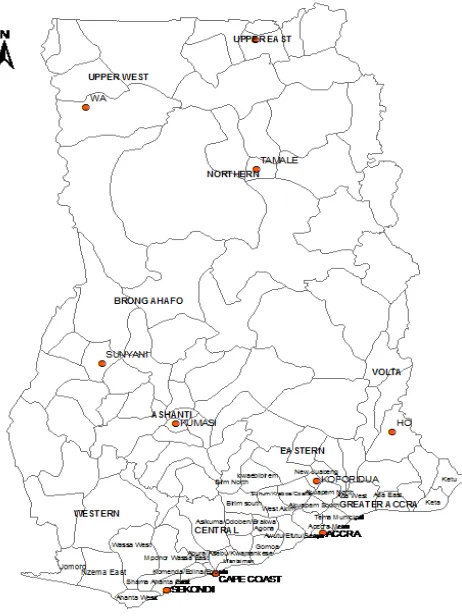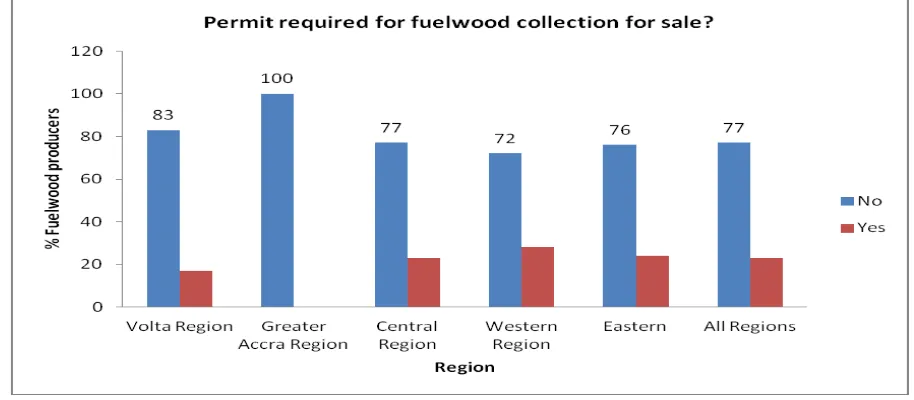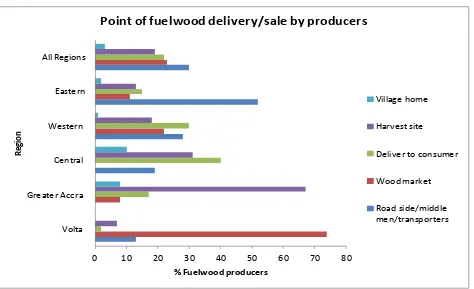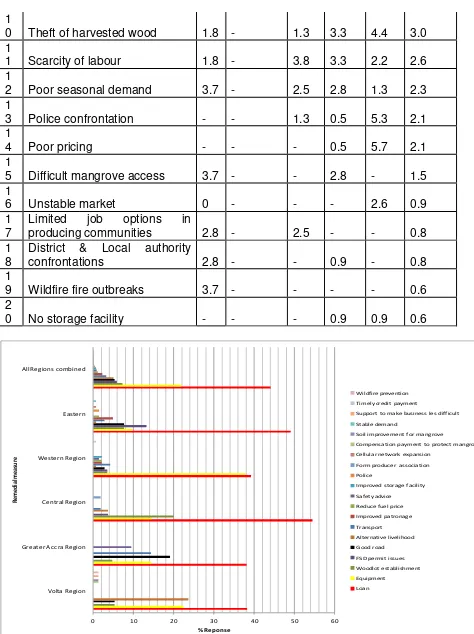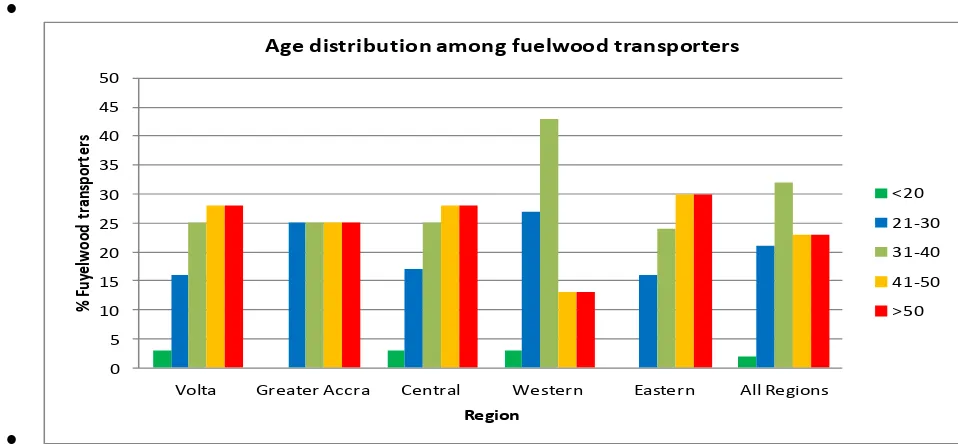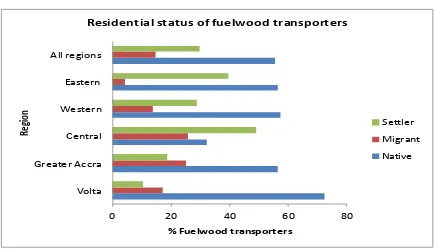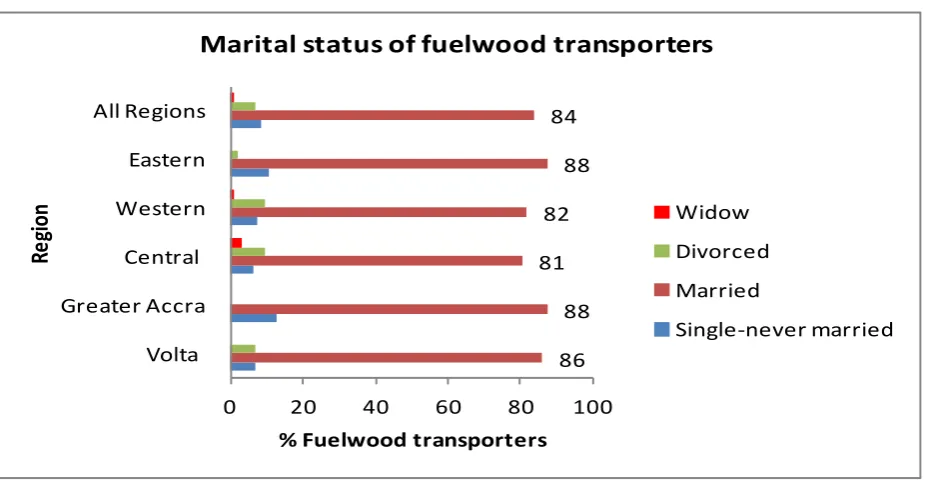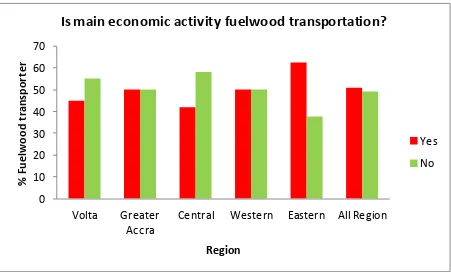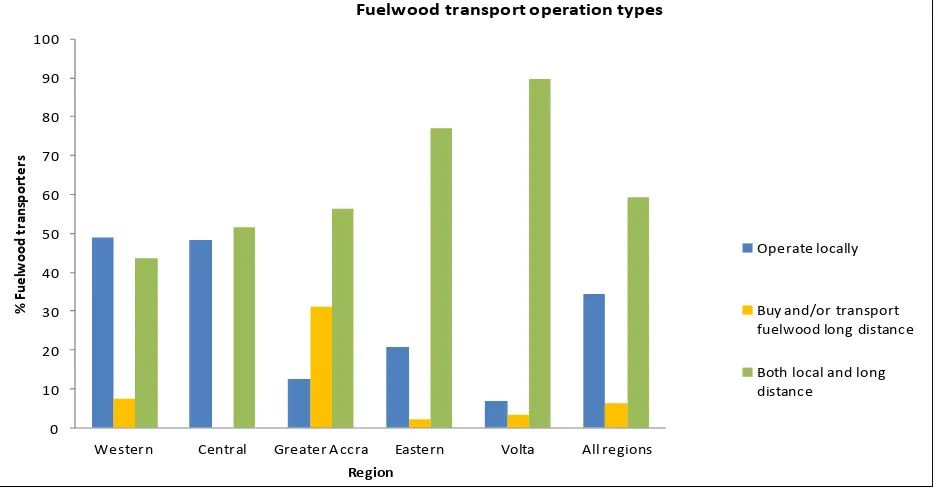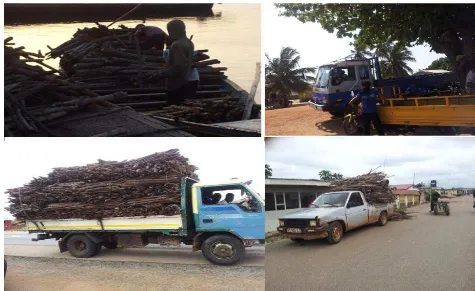SUSTAINABLE FISHERIES
MANAGEMENT PROJECT (SFMP)
Fuel Wood Value Chain Report
This publication is available electronically on the Coastal Resources website http://www.crc.uri.edu/projects_page/ghanasfmp/
For more information on the Ghana Sustainable Fisheries Management Project, contact: USAID/Ghana Sustainable Fisheries Management Project
Coastal Resources Center
Graduate School of Oceanography University of Rhode Island
220 South Ferry Rd.
Narragansett, RI 02882 USA
Tel: 401-874-6224 Fax: 401-874-6920 Email: [email protected]
Citation: Darko Obiri. B, Owusu-Afriyie, K., Kwarteng E,, Nutakor E, (2015). Fuel Wood Value Chain Report. The USAID/Ghana Sustainable Fisheries Management Project (SFMP). Narragansett, RI: Coastal Resources Center, Graduate School of Oceanography, University of Rhode Island and SNV Netherlands Development Organization.
GH2014_SCI011_SNV. 157 pp.
Authority/Disclaimer:
Prepared for USAID/Ghana under Cooperative Agreement (AID-641-A-15-00001) awarded on October 22, 2014 to the University of Rhode Island and entitled; the USAID/Ghana Sustainable Fisheries Management Project (SFMP).
ii
Detailed Partner Contact Information:
USAID/Ghana Sustainable Fisheries Management Project (SFMP) 10 Obodai St., Mempeasem, East Legon, Accra, Ghana
Brian Crawford Chief of Party [email protected]
Najih Lazar Senior Fisheries Advisor [email protected]
Patricia Mensah Communications Officer [email protected]
Bakari Nyari Monitoring and Evaluation Specialist [email protected]
Don Robadue, Jr. Program Manager, CRC [email protected]
Justice Odoi USAID Administrative Officer Representative [email protected]
Kofi.Agbogah
SNV Netherlands Development Organization #161, 10 Maseru Road,
E. Legon, Accra, Ghana 233 30 701 2440 Donkris Mevuta Kyei Yamoah
[email protected] Friends of the Nation Parks and Gardens Adiembra-Sekondi, Ghana 233 312 046 180
Peter Owusu Donkor Spatial Solutions
[email protected] #3 Third Nautical Close,
Nungua, Accra, Ghana 233 020 463 4488
Thomas Buck
SSG Advisors 182 Main Street
Burlington, VT 05401 (802) 735-1162
Victoria C. Koomson
[email protected] CEWEFIA
B342 Bronyibima Estate Elmina, Ghana
233 024 427 8377 Lydia Sasu
Darkuman Junction, Kaneshie Odokor Highway
Accra, Ghana 233 302 315894 Gifty Asmah
[email protected] Daasgift Quality Foundation
Headmaster residence, Sekondi College Sekondi, Western Region, Ghana 233 243 326 178
For additional information on partner activities: CRC/URI: http://www.crc.uri.edu
CEWEFIA: http://cewefia.weebly.com/
DAA: http://womenthrive.org/development-action-association-daa Daasgift:
https://www.facebook.com/pages/Daasgift-Quality-Foundation-FNGO/135372649846101 Friends of the Nation: http://www.fonghana.org Hen Mpoano: http://www.henmpoano.org
SNV: http://www.snvworld.org/en/countries/ghana SSG Advisors: http://ssg-advisors.com/
ACRONYMS
CCM Centre for Coastal Management
CDCS Country Development Cooperation Strategy
CEWEFIA Central and Western Region Fishmongers Improvement Association COMFISH Collaborative Management for A Sustainable Fisheries Future COP Chief of Party
CR Central Region
CRC Coastal Resources Center at the Graduate School Of Oceanography, University Of Rhode Island
CSLP Coastal Sustainable Landscapes Project DA District Authorities
DAA Development Action Association DAASGIFT Daasgift Quality Foundation
DFAS Department of Fisheries and Aquatic Sciences EG Economic Growth
EPA Environmental Protection Agency
FAO Food and Agricultural Organization Of The United Nations FASDP Fisherie s and Aquaculture Sector Development Program FC Fisheries Commision
FON Friends of Nation FSD Forestry Service Division FTF Feed the Future
HM Hen Mpoano
GIS Geographic Information System GOG Government Of Ghana
GSA Ghana Standards Authority GSS Ghana Statistical Survey
GSO Graduate School Of Oceanography, University Of Rhode Island IFAD International Fund for Agriculture Development
LPG Liquefied Petroleum Gas
MOFA Ministry Of Food and Agriculture
MOFAD Ministry Of Fisheries and Aquaculture Development NADMO National Disaster Management Organization
NGO Non-Governmental Organization NRM Natural Resources Management PPP Public Private Partnerships
REDD Reduced Deforestation And Degradation RCC Regional Coordinating Council
RWE Round Wood Equivalent
SFMP Sustainable Fisheries Management Program SMES Small and Medium Enterprises
SNV Netherlands Development Organization SS Spatial Solutions
SSG Ssg Advisors
UCC University of Cape Coast UN United Nations
URI University Of Rhode Island
USAID United States Agency for International Development USG United States Government
WA West Africa
WARFP West Africa Regional Fisheries Development Program WASH Water, Sanitation and Hygiene
iv
EXECUTIVE SUMMARY
This study analysed the fuelwood value chain for the fish smoking industry in 4 coastal regions of Ghana namely Volta, Greater Accra, Central and Western Regions as well as fuelwood producing areas in the moist semi-deciduous forest zone in the Eastern Region of Ghana. The objective was to analyze the nature of economic agents, transactions and constraints along the value chain to propose policy, development and research actions to enhance the chain. Literature was first consulted for general information on fuelwood use and management as well as policies and programs related to fuelwood across the globe and then specifically for fish smoking in Ghana. This helped in the preparation of the background to the study, the framework for analysing the fuelwood value chain and design of data instruments for gathering the requisite information for preparing this report. A total of 1400 actors were interviewed in 27 districts across the five regions for primary data. A cross section assessment of the status of the fuelwood resources and quantity of fuelwood flows along the chain in the five regions was also undertaken. The actors interviewed include fuelwood resource owners and producers, transporters and middlemen, traders and consumers/fish smokers as well as traditional authorities, government departments namely, the EPA, FSD, Wildlife Division, NADMO and District Assembly. Some NGOs working in the coastal areas were also consulted. The data has been analysed descriptively and quantitatively.
Results indicate that fuelwood is the primary source of fuel used by 98% of fish smokers along the coast. It is largely produced from natural sources from dead and standing trees on farmlands including fallows (49%) as well as dead trees and logging residues from government forest reserves (22%). However, production from mangroves cassia, neem and other plantations (29%) in the Volta estuaries and Central Region respectively on private lands are also key resources for fish smoking along the coast. For commercial purposes, there are distinct ownership and use rights for fuelwood resources. Fuelwood resources or land may be owned by a family, community or an individual and may be purchased outright or rented. Seventy fuelwood species are harvested for supply across the five regions, although the majority of the species have not been botanically identified. Twenty of these are most frequently harvested. The principal fuelwood species for coastal fish smoking based on preference and availability across the regions are as follows:
1. Volta
Mangrove in Keta and Ketu within the Volta estuary in local areas
Supplementary supplies of other species from the transition and semi-deciduous forests in Mid-Volta areas
2. Greater Accra
Neem mainly from the districts in the Accra plains for the Ada, LEKMA and Tema areas
Mangrove from Volta delta for particularly Ada areas
Celtis mildbraedii (Esa), Albizia zygia (Okoro), Terminalia ivorensis (Emire), Milicia excelsa (Odum), cocoa, and other species from the forests in the Eastern Region for the Accra Metropolitan area
3. Central
Celtis mildbraedii, Albizia zygia, Terminalia ivorensis and other species from the forests in the Eastern Region
A variety of species from clearings in the local farming areas
Plantations of Senna siamea (Cassia), Neem, Acacia sp. and old citrus stands within the local areas
4. Western
Funtumia elastica and other species from farmlands in adjacent forests Cocoa from old stands on farms in the local area
Rubber from old stands in the local area
is well developed. Although largely an informal sector, the economic agents involved in production, transporting, trading and consumption and their enterprises operate within some regulatory framework as follows:
Permit is required and a fee is paid for access to the wood material from reserves, farmlands and plantations for commercial extraction
A waybill is required for transporting fuelwood especially from government forest reserves, which is checked by security officials i.e. Police, Customs, en-route to market
Traders require permit in some cases to operate in a location
Traders, transporters and fish smokers are also required to pay income tax
Resource owners, government and traditional authorities earn some revenue from the fuelwood commodity and to some extent influence extraction from natural forest stands to ensure sustainability of the resource.
Fuelwood is delivered by producers and transporters in bundles or cylindrical block pieces. The bundles may consist of splits of wood or smaller diameter logs or saplings tied, while the blocks are larger diameter pieces of wood purchased for further splitting by the trader before sales or by the fish smoker for use. The bundle is the most common unit of sale. The mean farm gate price per bundle of variable weight and quantity of pieces is GHC2.50 (range: GHC2 in Central – GHC 3.5 in Western) while the retail price is GHC 8 on average (range: GHC5 in Central-GHC12 in Volta). The value addition is the transformation process from the standing tree to the splits or pieces of wood used by the consumer or fish smoker. This entails mainly labour for harvesting, cleaning, sizing into shorter length, splitting, bundling and packing. Overall, producers earned the least price (15.4%) and profit (20%) share across regions while traders earned the highest shares of 49% of the price spread and 50% profit along the chain for a bundle of fuelwood. Transporters may earn the least profit per bundle in some cases hence tend to overload trucks to maximize profit.
Although fuelwood may be pursued as a secondary income source by producers and traders, the fuelwood enterprise for fish smoking provide a vital source of income and livelihood option for households all year round. A wide range of people with various social status including educated or illiterate, employed or unemployed, native or migrant or settler, men or women, married or un-married including single headed households as well as the youth or aged are involved in the production, transportation, trading and consumption of fuelwood. However, at least 50% of the actors are of middle age and have had basic formal education with the majority of the uneducated being women. Generally men dominate the production and transportation in the chain while women are mostly involved in trading and consumption of the fuelwood.
Approximately 50% of actors are dependent mainly on fuelwood for fish smoking industry for survival. Seventy percent of producers do not own fuelwood resources and may be required to pay for harvesting and pay for access when necessary. Except in Volta and Central regions fuelwood is harvested mainly from the wild with hardly any coppice management measures. Seasonal fuelwood scarcity during the rainy season and fish bumper harvest control demand and supply. Scarcity of preferred fuelwood species was reported but on a limited scale.
With respect to mangroves, it was observed that the fishery economy in the Volta Region and adjacent communities in the Greater Accra Region thrive on mangrove wood along the estuary and islands. Mangroves in Greater Accra, Central and Western Region are also exploited for fish smoking but comparatively not well managed as done in the Volta Region. The mangrove ecosystem is also an important wood source for building as well as crab production. Three mangrove species were identified along the Volta Delta as follows:
Red mangrove (Rhizophora spp.) - found along the river/lake shores
White (Langaculaia spp.) and Black (Avicennia spp.) mangroves often referred to as white mangrove found further on islands.
vi
the slow rate of regeneration. Mangrove silviculture needs to be understood to enhance regeneration and to reduce the long regeneration period to less than 12 years.
Generally, a number of constraints were reported by the actors along the fuelwood value chain. Overall, inadequate financial resources for business operations and expansion as well as the lack of business management skills leading to high levels of crediting of supplies on delivery to clients i.e. traders and fish smokers and thereby reducing profits among producers, transporters and fish smokers in some cases were the principal constraint across the actors and regions. Scarcity and unavailability of suitable hard and heavy density wood species that burn longer were also mentioned. Owing to the decline in quality wood resources for fuelwood production, producers indicated that there have been decline in the quantity of fuelwood they produce now compared to what was being produced a decade ago, although the product is somehow available for extraction. As a result, long distances up to 20km have to be traversed to access suitable material for supply. They further stated that, acquisition of official permit for harvesting fuelwood from government production forest reserves is cumbersome and may be associated with high transaction costs. It was also observed that producers, transporters, traders and fish smokers as consumers in many of the areas surveyed were not properly organized into functional associations for business purposes.
Major challenges encountered by the transporters are the unavailability of reliable transport systems and the poor road network which causes delays in hauling fuelwood to final destinations as well as motor accidents. Moreover, harassment from law enforcement agencies including the police, FSD task force, customs officials among others during haulage is also a challenge to transporters and middlemen.
Generally, drudgery i.e. the laborious nature of the fuelwood production-to-consumption process was commonly reported across the economic agents along the chain in addition to high risks or occupational hazards associated with the activities along the chain. While producers encounter animal attacks, injuries and sometimes death, transporters encounter motor accidents, traction problems and confrontations with security officials. Traders mostly experience drudgery and injuries from handling wood during splitting and packing and also wood rot and theft in storage. Fish smokers encounter drudgery, poor working environment as most of them operate at the mercy of the weather but most importantly is the health related problems with smoke and heat from smoking fish. Forty to eighty nine percent of fish smokers reported health problems resulting from smoke across regions.
Actors are generally suggesting the provision of financial and material support to enhance activities along the chain. These include the following:
Loans to support business operations
Sheds and other enclosures to preserve wood and enhance working environment
Creation of wood depots for traders in fishing communities to help in the organization of the trade
Community cold rooms for fish preservation to reduce drudgery as a result of the perishability of fish they purchase for smoking
Promotion of woodlots to ensure availability of wood all year round
Education to reduce health related problems
Capacity building in business management skills
Review of policies to reduce FSD permit and access problems
Improved fish smoking stoves to reduce health problems related to wood smoke among fish smokers
Formation of actor associations for business and welfare purposes
needs to share the findings of this study to ensure that species promoted for fish smoking have acceptable or recommended levels of PAH to avoid gradual poisoning of consumers
To reduce drudgery and injury in fuelwood processing, appropriate wood splitters would be required to be introduced and promoted. Local artisans could be supported to fabricate, test these splitters for wider promotion among fuelwood producers, traders and fish smokers. A number of possible research activities have been proposed. The details are presented in the recommendation section of this report.
viii
TABLE OF CONTENTS
ACRONYMS ... III EXECUTIVE SUMMARY ... IV
1.0 INTRODUCTION AND BACKGROUND ... 1
1.1 FUELWOOD, LIVELIHOODS AND ECONOMIES ... 1
1.2 THE EFFECT OF FUELWOOD PRODUCTION ON THE ENVIRONMENT ... 3
1.3 EFFECT OF FUELWOOD USE ON HUMAN HEALTH ... 3
1.4 FUELWOOD AND DEVELOPMENT POLICIES ... 4
1.4.1 International policies ... 4
1.4.2 Ghana sectoral policies ... 8
1.4.3 Energy sector policies ... 8
1.4.5 Forest sector polices, programs and strategies ... 9
1.4.6 Other policies related to fuelwood ... 11
2.0 OBJECTIVE OF THE STUDY AND TERMS OF REFERENCE ... 13
2.1 EXPECTED RESULTS ... 13
3.0 METHODOLOGY ... 14
3.1 CONCEPTUAL FRAMEWORK FOR THE STUDY ... 14
3.2.STUDY AREAS AND RESPONDENTS ... 16
3.3. DATA COLLECTION AND ANALYSIS ... 27
3.3.1 Study strategy or approach ... 27
3.3.2 Data collected ... 27
3.3.3 Data analysis and presentation of the information... 28
4.0 FINDINGS ... 28
4.1OVERVIEW OF THE FUELWOOD VALUE CHAIN... 28
4.2. FUELWOOD PRODUCTION SYSTEM ... 29
4.2.1 Socio-demographic profile of fuelwood producers... 29
4.2.2 Fuelwood production enterprise operations ... 34
4.2.3 Type of fuel wood produced ... 36
4.2.4 Management of the fuelwood resource base ... 39
4.2.5 Access to fuelwood resources ... 42
4.2.6 HARVESTING/collection frequency and quantity harvested ... 43
4.2.7 Land use systems exploited for fuelwood ... 45
4.2.8 Regulations/controls on accessing fuelwood for harvesting and passage to market ... 46
4.2.9 Fuelwood species harvested and preferences ... 46
4.2.10 FUELWOOD harvesting, processing, packaging and distribution ... 51
4.2.11 Constraints in fuelwood production and remedial measures ... 52
4.3FUELWOOD TRANSPORT SYSTEM ... 55
4.3.1. Socio-demographic profile of fuelwood transporters ... 55
4.3.2 Fuelwood transport business operations ... 61
4.3.3 Fuelwood transported, clientele and demand ... 64
4.3.4 Constraints in fuelwood transportation and distribution and remedial measures . 66 4.4 FUELWOOD TRADING SYSTEM ... 69
4.4.1 Socio-demographic profile of fuelwood traders ... 69
4.4.2 The fuelwood trading enterprise ... 74
4.4.3 Constraints in trading of fuelwood and remedial measures ... 78
4.5 FUELWOOD CONSUMPTION ... 77
4.5.1. Socio-demographic profile of fuelwood consumers in fish smoking industry ... 77
4.5.3 Forms of fish smoked and fuel type used ... 83
4.5.4 Fuelwood species used, reasons for preferences supply sources ... 86
4.5.5 Constraints in the use of fuelwood for fish smoking and remedial measures ... 92
4.6 PROFIT ALONG THE FUELWOOD VALUE CHAIN ... 95
4.7 FISH SMOKING AND MANGROVE ECOSYSTEM: IMPLICATIONS FOR SUSTAINABLECONSERVATIONOFFISHNURSERIES ... 98
4.7.1 INTRODUCTION ... 98
4.7.2 Mangrove resources in the coastal regions of Ghana ... 99
4.7.3 Harvesting and stand management ... 101
4.7.4 Dependency on mangroves for livelihood ... 103
4.7.5 Threats or challenges to sustainability ... 104
4.7.6 Options for sustainable utilization and conservation of mangroves as fish nurseries ... 105
5.0 CONCLUSIONS... 106
6.0 RECOMMENDATIONS: OPTIONS FOR ENHANCING THE FUELWOOD VALUE CHAIN ... 107
EVERY SEGMENT OF THE VALUE CHAIN ... 107
6.1 RESOURCE GOVERNANCE ... 107
6.2 BUILDING CAPACITY AND PROMOTING WOODLOTS FOR FUELWOOD PRODUCTION ... 107
6.3 PROMOTION OF APPROPRIATE END-USE DEVICE FOR EFFICIENT USE OF FUELWOOD AMONG FISH SMOKERS ... 108
6.4 IMPROVING WOOD PRESERVATION/STORAGE, WORKING ENVIRONMENT AND HEALTH SAFETY FOR FUELWOOD TRADERS AND FISH SMOKERS ... 108
6.5 RESEARCH ... 108
6.6 INTERVENTIONS TO PROTECT MANGROVES AND FISH NURSERY SITES ... 109
REFERENCES ... 110
ANNEXES ... 112
LIST OF TABLES
Table 1 Employment generated by different types of energy ... 1Table 2 Species recommended for fuelwood plantation development in Ghana... 10
Table 3 Proportion of respondents/actor categories interviewed in 27 districts and data collected ... 16
Table 4 Biophysical and economic features of coastal and forest regions surveyed ... 20
Table 5 Age of fuelwood producers across regions ... 30
Table 6 Household sizes of fuelwood producers ... 33
Table 7 Number of years experience in fuelwood production business ... 34
Table 8 Number of assistants engaged by fuelwood producers ... 36
Table 9 Number of years species regenerate for harvesting ... 40
Table 10 Distance travelled to harvest fuelwood ... 41
Table 11 Frequency of harvest during the major fish season ... 43
Table 12 Frequency of fuelwood harvest during the minor fish season ... 45
Table 13Mean size of fuelwood plantation owned for all regions combined ... 46
Table 14 Species harvested for sale by fuelwood producers ... 47
Table 15 Constraints in fuelwood production ... 53
Table 16 Measures suggested for alleviating fuelwood production constraints ... 55
Table 17 Age of fuelwood transporters ... 56
Table 18 Number of years of residency in community among fuelwood transporters ... 58
Table 19 Household size for fuelwood transporters ... 58
x
Table 21 Number of dependents in transporter households (i.e.<15 and >65 years old) ... 60
Table 22 Number of years experience in fuelwood transportation ... 61
Table 23 Frequency of trips made transporting fuelwood to clients ... 63
Table 24 Constraints in fuelwood transportation ... 67
Table 25 Measures suggested for alleviating fuelwood transport constraints ... 68
Table 26 Age of fuelwood traders ... 69
Table 27 Mean number of years lived in community-all regions combined ... 71
Table 28 Mean household size for fuelwood traders-all regions combined ... 72
Table 29 Number of years experience in fuelwood trading ... 78
Table 30 Membership strength of fuelwood consumer association... 82
Table 31 Distribution of membership strength of fuelwood consumer/fish smoker association ... 82
Table 32 Species used in fish smoking in the Volta Region... 87
Table 33 Species used in fish smoking in the Central Region ... 88
Table 34 Species used in fish smoking in the Greater Accra Region ... 89
Table 35 Species used in fish smoking in the Western Region ... 91
Table 36 Constraints encountered in fuelwood consumption for fish smoking ... 93
Table 37 Measures suggested by fuelwood consumers to alleviate constraints ... 94
LIST OF FIGURES
Figure 1 Ghana Woodfuel (i.e. Firewood and charcoal) supply – demand balance ... 2Figure 2 PAH levels on sardinella from five fuelwood species ... 4
Figure 3 A map of a typical fuelwood value chain. ... 15
Figure 4 Framework for analysing costs and returns for estimating profit along the fuelwood value chain ... 16
Figure 5 Map of Ghana showing districts surveyed ... 19
Figure 6 Ecological map of Ghana showing fuelwood production, trading and consumption areas surveyed ... 20
Figure 7 Map of the fuelwood value chain for fish smoking in Ghana ... 28
Figure 8 Gender of fuelwood producers across regions ... 30
Figure 9 Age distribution among fuelwood producers ... 31
Figure 10 Residential status of fuelwood producers ... 31
Figure 11 Educational status of men and women fuelwood producers in survey regions ... 32
Figure 12 Marital status of fuelwood producers ... 32
Figure 13 Dependency on fuelwood production for income ... 34
Figure 14 Other major income sources for fuelwood producers ... 34
Figure 15 Number of years experience in fuelwood production ... 35
Figure 16 Initiator of producer into fuelwood business ... 35
Figure 17 Employing others in fuelwood production business ... 36
Figure 18 Membership of fuelwood producer association ... 36
Figure 19 Proportion of producers supplying the different fuelwood types ... 37
Figure 20 Clients producers supply with fuelwood ... 38
Figure 21 Producers perception of the status of demand for fuelwood throughout the year ... 39
Figure 22 Producers claims on their knowledge on regeneration of fuelwood species ... 39
Figure 23 Producer perception of fuelwood availability ... 41
Figure 24 Producer claims on distance travelled to harvest fuelwood for sale ... 41
Figure 25 Producer perception of causes of decline in fuelwood resources ... 42
Figure 26 Ownership of fuelwood resource among producers ... 43
Figure 28 Fuelwood plantation sizes owned ... 46
Figure 29 Requisition for permit to harvest fuelwood for sale ... 47
Figure 30 Who grants permit for fuelwood harvesting ... 47
Figure 31 Fuelwood species harvested for sale across regions ... 46
Figure 32 Percent distribution of producers processing fuelwood before sale ... 52
Figure 33 Producer fuelwood sale/delivery points ... 52
Figure 34 Constraints encountered in fuelwood production ... 53
Figure 35 Measures fuelwood producers suggested for alleviating production constraints .... 54
Figure 36 Gender of fuelwood transporters ... 56
Figure 37 Age distribution among fuelwood transporters ... 56
Figure 38 Educational status of fuelwood transporters... 57
Figure 39 Residential status of fuelwood transporters ... 57
Figure 40 Marital status of fuelwood transporters ... 59
Figure 41 Dependency on fuelwood transportation for income ... 61
Figure 42 Transport systems operated ... 62
Figure 43 Vehicle ownership among fuelwood transporters ... 63
Figure 44 Transporters claims of record keeping on business ... 64
Figure 45 Membership of fuelwood transporters association ... 64
Figure 46 proportion of transporters indicating their clients for fuelwood delivery ... 65
Figure 47 Proportion of transporters indicating forms of fuelwood delivered to clients... 65
Figure 48 Proportion of fuelwood transporters indicating nature of demand for their services ... 66
Figure 49 Constraints in fuelwood transportation ... 67
Figure 50 Measures proposed by transporters to alleviate constraints ... 68
Figure 51 Gender of fuelwood traders for the coastal fish smoking industry ... 70
Figure 52 Formal educational status of male and female fuelwood traders ... 70
Figure 53 Residential status of fuelwood traders ... 71
Figure 54 Number of years traders have lived in their community ... 71
Figure 55 Marital status of fuelwood traders ... 72
Figure 56: Household size distribution for fuelwood traders ... 73
Figure 57 Reliance on fuelwood trading as main economic activity/income source ... 73
Figure 58 Other economic activities undertaken by fuelwood traders for income ... 74
Figure 59 Fuelwood trader categories... 75
Figure 60 Fuelwood type sold among traders ... 76
Figure 61 Clientele of fuelwood traders ... 77
Figure 62 Availability of fuelwood trader association in regions surveyed ... 77
Figure 63 Membership of fuelwood trader association ... 78
Figure 64 Constraints in fuelwood trading ... 76
Figure 65 Measures suggested by traders to alleviate constraints in fuelwood trading ... 77
Figure 66 Age distribution among fuelwood consumers ... 78
Figure 67 Gender of fuelwood consumers/fish smokers ... 78
Figure 68: Educational status of fuelwood consumers/fish smokers ... 79
Figure 69: Residential status of fuelwood smokers ... 79
Figure 70 Number of years fuelwood consumers/fish smokers have lived in their communities ... 80
Figure 71 Size of fuelwood consumer/fish smoker households ... 80
Figure 72 Number of years of experience in fish smoking ... 81
Figure 73 Membership of fish smoker/Consumer association ... 82
Figure 74 Reasons for the formation of fish smokers association ... 83
xii
Figure 76 Distribution of quantities of frozen fish smoked per day ... 84
Figure 77 Fuel types used for fish smoking ... 84
Figure 78 Other fuels used in addition to wood for fish smoking ... 85
Figure 79 Proportion of fish smokers owning stoves used for fish smoking ... 85
Figure 80 Distribution of the number of stoves owned by fish smokers ... 86
Figure 81 Proportion of consumers/fish smokers indicating clients from who they secure their fuelwood ... 87
Figure 82 Constraints encountered by fuelwood consumers/fish smokers ... 92
Figure 83 Measures suggested for alleviating constraints in fuelwood consumption for fish smoking ... 94
Figure 84 Costs, gains and worth of value added per bundle of fuelwood along the chain - All regions ... 95
Figure 85 Costs, gains and worth of value added per bundle of fuelwood along the chain -Volta ... 96
Figure 86 Costs, gains and worth of value added per bundle of fuelwood along the chain -Greater Accra ... 97
Figure 87 Costs, gains and worth of value added per bundle of fuelwood along the chain – Central ... 97
Figure 88 Costs, gains and worth of value added per bundle of fuelwood along the chain- Western ... 98
Figure 89 Tenure to mangrove land in Ghana ... 100
LIST OF PLATES
Plate 1 Female fuelwood producer –Eastern Region ... 30Plate 2 A couple and household engaged in fuelwood production-Eastern Region ... 33
Plate 3 Types/forms of fuelwood produced-assembled at production site for haulage ... 37
Plate 4 Unmanaged coppice growth and natural regeneration in forest and mangrove stands 40 Plate 5 (above): Key fuelwood species and regions used for the fish smoking ... 51
Plate 6 (below): Sources of fuelwood in various land use types ... 51
Plate 7 Vehicles used in transporting fuelwood ... 63
Plate 8 Wholesale/retail fuelwood trading at Chokor fishing community-Greater Accra ... 75
Plate 9 Types of fuelwood for sale ... 76
Plate 10: Smoke pollution from fish smoking ... 93
Plate 11 Vehicles loaded with fuelwood for delivery in fishing communities in the Central Region ... 96
Plate 12 Some mangrove sites visited in the Volta and Central Regions ... 99
Plate 13 Estimating mangrove wood volumes in the Keta District of the Volta Region ... 100
Plate 14 Identifying mangrove species in the Keta District of the Volta Region ... 101
Plate 15 Three mangrove species along the Volta Estuaries ... 101
Plate 16 Harvesting of mangrove for sale ... 102
Plate 17 Mangrove natural regeneration at the Volta estuaries ... 102
Plate 18 Livelihood options associated with the mangrove in the Volta estuaries ... 103
Plate 19 Mangrove as fish nursery, landscape scenic beauty and barrier to erosion and pollutants -Keta District ... 104
Plate 20 Trading mangrove fuelwood: Units of sale at the harvesting point and on the market ... 104
1.0 INTRODUCTION AND BACKGROUND
Wood has been used as fuel for millennia in both developed and under developed countries worldwide. Burning of wood is the largest use of energy derived from a solid fuel biomass. Wood is used for cooking and heating in many places around the world in a stove or an open fire. It is also used as a fuel in many industrial processes and occasionally for fuelling steam engines and steam turbines that generate electricity. Global interest in fuelwood as a renewable biomass energy resource has soared in recent times because it can be developed and used sustainably. As a sustainable energy source, fuel wood is viable for generating electricity in areas with easy access to forest products and by-products (Wikipedia, 2015). Fuelwood1 is consumed by more than two billion people globally (FAO, 2005). Global fuelwood consumption is estimated at 1.8 billion m3. This comprises 7% of the world’s total primary energy consumption with 76% of it being used in developing countries particularly in Africa (Trossero, 2002).
1.1 Fuelwood, livelihoods and economies
Fuelwood production has been an age-old activity in most parts of the developing world for subsistence and commercial purposes. Studies in India, Pakistan and Kenya have shown that wood and other biomass resources generate at least 20 times more local employment within the national economy than other forms of energy, per unit consumed. This is due to the huge amount of unskilled manpower or labour required for harvesting, processing, transporting and trading of this fuel (ESDA, 2005). In the Democratic Republic of Congo (DRC), firewood contributes 12% to producers’ household income, for fuelwood producers around Kisangani and supports basic needs of 65% of them, thereby helping to reduce poverty (Schure et al., 2014).
Table 1 Employment generated by different types of energy
Fuel Amount of fuel
per Terajoule (TJ)
Employment per TJ energy
in person days
Fuelwood 62 100-700
Charcoal 33 200-350
Coal 43 20-40
Kerosene 29 10
LPG 22 10-20
Electricity(MWh) 228 80-100
Source: Trossero, 2002
Generally, Fuelwood production and marketing in most parts of Africa requires only minimal financial and human resources. The raw material which is the wood is often obtained for free. The fuelwood business is thus suitable for the socio economically rural poor, contributing to their household income as well as providing a safeguard against food-shortages, unemployment and other similar poverty-related risks. For instance in Kenya fuelwood collection is pursued by the poorest members of the community who, in general, have a low
1
2
social profile (Kituyi, 2001). In Ghana fuelwood gathering and sale coupled with fuel-based income generating activities are very important livelihoods in forest fringe rural communities (Amuah, 2011). Poverty levels are generally high in Ghana with 30 percent of the population living on less than $1 a day and 54 percent living on less than $2 a day (World Vision USA, 2015). Forty-nine percent of the Ghanaian population live in rural areas (GSS, 2010) with 39.2% of them being poor or living at the poverty line (IFAD, 2015). Many of the rural population rely of adjacent forest resources particularly, fuelwood as secondary income source to supplement farm income (Obiri et al., 2014).
In Ghana like in many parts of Africa, fuelwood constitutes about 70% of energy consumed (Ghana Energy Commission, 2006). It is a major source of domestic energy in rural areas used for cooking, heating and lighting as well as energy for rural and cottage industries (Aabeyir, 2011; Anang, et al., 2011; Somuah et al, 2010). Seventy-three percent and 25% of the population use firewood for cooking in rural and urban areas respectively (GSS, 2010). In urban areas, fuelwood is the main source of energy for commercial activities particularly for processing enterprises as well as service industries and institutions with some domestic consumption. According to FAO (2000) more than 2.2 million households depend on fuelwood or charcoal for cooking and heating in Ghana, and at least 280,000 of them use it for small-scale processing activities, such as fish smoking, gari making, pito brewing, akpeteshi distillation, pottery making, oil extraction (from palm fruits, coconut, groundnut, shea butter. Fuelwood thus makes a significant contribution to food preservation, food security and cash earnings for rural and urban people. In addition, there are also about 600, 000 small-scale enterprises in commercial activities, such as chop bars, street food and grills, which depend on fuelwood or charcoal as their main source of energy (Broadhead et al, 2001).
For centuries fuelwood production and marketing in Ghana has been done by subsistence and commercial entities whose activities have remained largely informal with scarcely any management procedures to ensure sustainability (Aabeyir, 2011). This has resulted in extensive exploitation of fuelwood resources with increasing demand over the years. Ghana is one of the countries with high per capita fuelwood demand in West Africa (Anang et al., 2011). However, supply-consumption trends from 2006-2012 show a mean surplus of 4.1kilotonnes of fuelwood not consumed after extraction (Figure 1a) (Ghana Energy Commission, 2013). This means fuelwood supply often exceeds demand. The excess possibly goes to waste from decomposition of the wood. The annual per capita fuelwood consumption is estimated to be 1.0 m3 round wood equivalent (FAO, 2010)
Source: Ghana Energy Commission, 2013
1.2 The effect of fuelwood production on the environment
Fuelwood or firewood is the cheapest form of wood fuel in Africa because its production usually requires no complex expensive equipment and often procured at no greater cost than labour for collecting and processing (Arnold et al., 2003). For this reason fuelwood is extensively exploited for income and for subsistence in both rural and urban areas across the region. Thus, fuelwood production across Africa has generally been criticized as a driver of deforestation (Parrotta et al., 2015).
The burning of wood for heat for household and industrial purposes also contributes to environmental decline. The environmental impact of using wood as a fuel depends on how it is burnt. Higher temperatures result in more complete combustion and less noxious gases as a result of pyrolysis. Some may regard the burning of wood from a sustainable source as carbon neutral. However, a tree, over the course of its lifetime, absorbs as much carbon (or carbon dioxide) as it releases when burnt. (Wikipedia, 2015). Burning wood creates numerous by-products, some of which may be useful (heat and steam), and others that are undesirable, irritating or dangerous. One by-product of wood burning is wood ash, which in moderate amounts is a fertilizer (mainly potash), contributing minerals, but is strongly alkaline as it contains potassium hydroxide (lye). Wood ash is also used to manufacture soap. Some irritating and potentially dangerous by-products from the partial burning of wood include smoke containing water vapour, carbon dioxide and other chemicals and aerosol particulates, including caustic alkali (flyash). A major component of wood smoke is fine particles that may account for a large portion of particulate air pollution in some regions. During cooler months, wood heating accounts for as much as 60% of fine particles in air in Melbourne, Australia (Wikipedia, 2015).
It is reported that slow combustion stoves increase efficiency of wood heaters burning logs, but also increase particulate production. Low pollution from slow combustion stoves are a current area of research. An alternative approach is to use pyrolysis to produce several useful biochemical by-products, and clean burning charcoal, or to burn fuel extremely quickly inside a large thermal mass, such as a masonry heater. This has the effect of allowing the fuel to burn completely without producing particulates while maintaining the efficiency of the system. In some of the most efficient burners, the temperature of the smoke is raised to a much higher temperature where the smoke will itself burn (e.g. 609 °C) for igniting carbon monoxide gas). This may result in significant reduction of smoke hazards while also providing additional heat from the process. By using a catalytic converter, the temperature for obtaining cleaner smoke can be reduced. Some U.S. jurisdictions prohibit sale or installation of stoves that do not incorporate catalytic converters (Wikipedia, 2015).
1.3 Effect of fuelwood use on human health
4
heartwood of a tree contains the highest amounts of toxic substances, but precautions should be taken if one is burning wood of an unknown nature, since some trees' wood smoke can be highly toxic (Wikipedia, 2015).
Generally, men and women have different demands on energy due to the existing socio-cultural and traditional roles. Women do most of the cooking. They are also heavily involved in fuelwood collection. Traditional use of firewood has negative effects on women’s health such as respiratory diseases, eye irritation, etc. Gender division of labour and environmental degradation are increasing women’s time burdens (Neequaye Tetteh, 1985). A report in the Ghanaian Daily Guide news paper indicates possible inhalation of poisonous substances into the respiratory tracts of women who use charcoal in enclosures for cooking (Daily Guide, 2015).
Studies conducted by SNV Ghana indicates that, some of the key traditionals wood species used for smoking fish in Ghana have various levels of Policyclic Aromatic Hydrocarbons (PAH). Using five wood species, neem, red mangroves, white mangroves, rubber and bamboo to smoke sardinella on common stove (Chorkor smoker), the PAH levels measured on the fish far exceeded the EU PAH standard for safe consumption (Figure 1b). Higher levels of PAH on smoked fish has potential health hazards. This is because the high PAH has carcinogenic potential causing breast cancer, cervical cancer, liver, prostate, pancreas and cancer of hemapoietic organs.
Figure 2 PAH levels on sardinella from five fuelwood species 1.4 Fuelwood and development policies
1.4.1 International policies
Goal 1: End poverty in all its forms everywhere
1.1 Eradicate extreme poverty for all people everywhere, currently measured as people living on less than $1.25 a day
1.4 Ensure that all men and women, in particular the poor and the vulnerable, have equal rights to economic resources, as well as access to basic services, ownership and control over land and other forms of property, inheritance, natural resources, appropriate new technology and financial services, including microfinance
1.5 Build the resilience of the poor and those in vulnerable situations and reduce their exposure and vulnerability to climate-related extreme events and other economic, social and environmental shocks and disasters
1.a Ensure significant mobilization of resources from a variety of sources, including through enhanced development cooperation, in order to provide adequate and predictable means for developing countries, in particular least developed countries, to implement programmes and policies to end poverty in all its dimensions
1.b Create sound policy frameworks at the national, regional and international levels, based on pro-poor and gender-sensitive development strategies, to support accelerated investment in poverty eradication actions
Goal 2: End hunger, achieve food security and improved nutrition and promote sustainable agriculture
2.3 Double the agricultural productivity and incomes of small-scale food producers, in particular women, indigenous peoples, family farmers, pastoralists and fishers, including through secure and equal access to land, other productive resources and inputs, knowledge, financial services, markets and opportunities for value addition and non-farm employment 2.4 Ensure sustainable food production systems and implement resilient agricultural practices that increase productivity and production, that help maintain ecosystems, that strengthen capacity for adaptation to climate change, extreme weather, drought, flooding and other disasters and that progressively improve land and soil quality
2.5 Maintain the genetic diversity of seeds, cultivated plants and farmed and domesticated animals and their related wild species, including through soundly managed and diversified seed and plant banks at the national, regional and international levels, and promote access to and fair and equitable sharing of benefits arising from the utilization of genetic resources and associated traditional knowledge, as internationally agreed
2.a Increase investment, including through enhanced international cooperation, in rural infrastructure, agricultural research and extension services, technology development and plant and livestock gene banks in order to enhance agricultural productive capacity in developing countries, in particular least developed countries
Goal 7: Ensure access to affordable, reliable, sustainable and modern energy for all
6
7.3 Double the global rate of improvement in energy efficiency
7a. Enhance international cooperation to facilitate access to clean energy research and technology, including renewable energy, energy efficiency and advanced and cleaner fossil-fuel technology, and promote investment in energy infrastructure and clean energy technology
7.b Expand infrastructure and upgrade technology for supplying modern and sustainable energy services for all in developing countries
Goal 12: Ensure sustainable consumption and production patterns
12.1 Implement the 10-year framework of programmes on sustainable consumption and production, all countries taking action, with developed countries taking the lead, taking into account the development and capabilities of developing countries
12.2 Achieve the sustainable management and efficient use of natural resources
12.3 Halve per capita global food waste at the retail and consumer levels and reduce food losses along production and supply chains, including post-harvest losses
12.4 Achieve the environmentally sound management of chemicals and all wastes throughout their life cycle, in accordance with agreed international frameworks, and significantly reduce their release to air, water and soil in order to minimize their adverse impacts on human health and the environment
Goal 13: Take urgent action to combat climate change and its impacts
13.1 Strengthen resilience and adaptive capacity to climate-related hazards and natural disasters in all countries
13.2 Integrate climate change measures into national policies, strategies and planning
13.3 Improve education, awareness-raising and human and institutional capacity on climate change mitigation, adaptation, impact reduction and early warning
13.a Implement the commitment undertaken by developed-country parties to the United Nations Framework Convention on Climate Change to a goal of mobilizing jointly $100 billion annually by 2020 from all sources to address the needs of developing countries in the context of meaningful mitigation actions and transparency on implementation and fully operationalize the Green Climate Fund through its capitalization as soon as possible
13.b Promote mechanisms for raising capacity for effective climate change-related planning and management in least developed countries and small island developing States, including focusing on women, youth and local and marginalized communities
Goal 14: Conserve and sustainably use the oceans, seas and marine resources for sustainable development
restoration in order to achieve healthy and productive oceans
14.5 Conserve at least 10 per cent of coastal and marine areas, consistent with national and international law and based on the best available scientific information
14.7 Increase the economic benefits to Small Island developing States and least developed countries from the sustainable use of marine resources, including through sustainable management of fisheries, aquaculture and tourism
Goal 15: Protect, restore and promote sustainable use of terrestrial ecosystems, sustainably manage forests, combat desertification, and halt and reverse land degradation and halt biodiversity loss
15.1 Ensure the conservation, restoration and sustainable use of terrestrial and inland freshwater ecosystems and their services, in particular forests, wetlands, mountains and drylands, in line with obligations under international agreements
15.2 Promote the implementation of sustainable management of all types of forests, halt deforestation, restore degraded forests and substantially increase afforestation and reforestation globally
15.3 Combat desertification, restore degraded land and soil, including land affected by desertification, drought and floods, and strive to achieve a land degradation-neutral
15.5 Take urgent and significant action to reduce the degradation of natural habitats, halt the loss of biodiversity and, by 2020, protect and prevent the extinction of threatened species 15.6 Promote fair and equitable sharing of the benefits arising from the utilization of genetic resources and promote appropriate access to such resources, as internationally agreed
15.9 Integrate ecosystem and biodiversity values into national and local planning, development processes, poverty reduction strategies and accounts
15.a Mobilize and significantly increase financial resources from all sources to conserve and sustainably use biodiversity and ecosystems
15.b Mobilize significant resources from all sources and at all levels to finance sustainable forest management and provide adequate incentives to developing countries to advance such management, including for conservation and reforestation
8
1.4.2 Ghana sectoral policies
Policies, regulatory, legislative frameworks and institutional arrangements in place to provide direction for development and sustainable management of woodfuel resources in Ghana include:
1. National Energy Policy 2. Bio-energy policy
3. Renewable Energy Act, 2011 (Act 832) 4. Ghana Forest and Wildlife Policy (2012) 5. The Ghana REDD+ strategy
6. Forest Investment Plan (FIP)
7. Ghana forest plantation development strategy (2015-2040) 8. National Land Policy (1999, with revision in 2002) 9. National Wildfire Policy
1.4.3 Energy sector policies
In general Ghana Energy Policy, Bio-energy Policy and the Renewable Energy Act seek to create the enabling environment for the sustainable development and utilization of woodfuel in the country.
National Energy Policy:
The overall national energy policy target is to attain 10% Renewable Energy (RE) in national energy mix by 2020.
Bio-energy Policy
In 2010, the Energy Commission of Ghana developed a Bio-energy Policy with sections on the development of the wood fuel sub-sector. The overall goal of the Bio-energy Policy is “to develop and promote the sustainable supply and utilization of bio-energy to ensure energy security for Ghana whilst maintaining adequate food security. The Bio-energy Policy also considers the supply and demand side of wood fuels and proposes strategies such as the promotion of woodlot cultivation, improved carbonisation technology and the promotion of efficient end use devices that will ensure the sustainable management of the woodfuel resources.
The key policy issues addressed under woodfuel thematic area are to promote and ensure sound management as well as expansion of the country’s natural forest for sustainable supply of wood fuel. These include:
I. Sustainability of woodfuel supply
II. Development of efficient supply and end-use technologies for woodfuel production and use,
III. Efficiency in packaging, marketing and transportation of woodfuel, and strengthening of institutional and regulatory framework
The policy strategies include:
Identification and provision of incentives (financial and non-financial) for the development of woodlots in savannah and transitional zones under international funding protocols such as the Desertification Fund and Clean Development Mechanism (CDM) Fund
It also seeks to encourage the collaboration between the District Assemblies and Traditional Authorities to educate and release land to prospective individuals (especially women) and groups for wood fuel woodlots and plantation establishment. The key challenges to be addressed by the policy include:
Sustainability of sources of supply
Production of efficient technologies for wood fuel production and use
Substitution of traditional wood fuels with more modern fuels like LPG
Efficiency in the transportation of wood fuel
Improved packaging and marketing
Strong coordination in institutional and regulatory arrangements
Renewable Energy Act, 2011 (Act 832)
The Renewable Energy Act (Act 832) was passed in 2011. The objective of the ACT is to ensure the development, management and utilization of renewable energy sources (including biomass) for the production of heat and power in an efficient and environmental friendly sustainable manner. The Renewable energy Act is aimed at the following:
Stimulate massive investment into the renewable energy sector.
Ensure the development and implementation of programmes to sustain woodfuel production and consumption
The Energy Commission is mandated to collaborate with relevant institutions to ensure the development and implementation of programmes to sustain woodfuel production and consumption including:
Woodlot plantations
Improved kilns
Improved charcoal stove promotion The strategic directions include the following:
A framework to support the development and utilization of renewable energy sources
An enabling environment to attract investment in renewable energy sources
The promotion and use of renewable energy
The building of indigenous capacity in technology for renewable energy sources
The diversification of supplies to safeguard energy security
Public education on renewable energy production and utilisation
The regulation of the production and supply of woodfuel and bio-fuel
1.4.5 Forest sector polices, programs and strategies
10
This policy provides strategic directions and actions to be pursued in achieving sustainable management and development of commercial woodfuel supplies; and to develop systems and structures to support the sustainable establishment of commercial woodfuel plantations.
The Forest sector investment program (FIP)
The strategies under FIP for the wood fuel sector concerns enhancement of carbon stocks to provide an alternative opportunity for clean wood fuel production. Improved management of ‘fuel wood’ landscapes and maintenance of NTFPs are an important source of livelihood for women. Component 3 of the Forest Investment Plan is focused on sustainable woodfuel production in the savannah transition zone. This seeks to ensure the following:
Support options for increased efficiency in charcoal production
Support sustainable fuelwood harvesting and fuelwood production systems to produce emissions reductions/removals and other benefits, (potentially including investment in woodlots, establishment/engagement with CREMAs, charcoal producer “guilds” and community land use and natural resource planning)
Leverage co-financing and private sector investment in woodfuel plantations
Ghana National REDD+ Strategy
The Ghana National REDD+ Strategy document acknowledges that one of the principal drivers of deforestation and degradation in Ghana is fuelwood harvesting or exploitation as it is a major source of energy. One of the strategies for addressing environmental decline associated with wood harvesting in particularly the transition and savannah zones is to improve sustainability of fuelwood harvest & use. It is recommended in the document that the Ministry of Energy (MOE) with a core mandate on securing sustainable energy, assist in both providing complementary policies and implementation of REDD interventions (FC, 2015).
Ghana forest plantation development strategy 2015-2040
A national forest plantation development strategy has been drafted for Ghana for 2015-2040. It is reported in this document that 90% of woodfuel needs of the country is obtained directly from the natural forest estate. The remaining 10% is from wood waste i.e. logging and sawmill residue, and planted forests. The continuous use of woodfuel obtained from the natural forests if not managed sustainably would lead to the depletion of the country’s forests. It is imperative that measures are put in place to ensure the sustainable supply of woodfuel to meet the growing demand of woodfuels in the country. One major measure outlined in the plantation development strategy is to plant woodlots for fuelwood production. It is estimated that the annual demand for fuelwood in 2013 was 16,800,000 (m3RWE). Supply from existing forests is 15,960,000 (m3RWE). The deficit to be met from plantations is 840, 000 9 (m3RWE). It is estimated that 56,000 ha of land would need to be planted at rate of 2,240 per annum to satisfy this deficit (FC & MLNR, 2013). Specific species have been recommended for planting woodfuel woodlots based on their suitability to the growing conditions across the broad ecological zones of Ghana (Table 2).
VEGETATION
ZONE SCIENTIFC NAME
COMMON/TRADE NAME
KEY USES
Coastal Savannah Senna siamea Cassia Fuel wood
Millettia thonningii Millettia Fuel wood
Acacia mangium Acacia Fuel wood
Acacia
auriculiformis Acacia Fuel wood
Azadirachta indica Neem Fuel wood
Eucalyptus spp. Eucalyptus Fuel wood
Transitional Zone Acacia mangium Acacia Charcoal
Senna siamea Cassia Fuel wood
Northern Zone Acacia mangium Acacia Fuel wood
Millettia thonningii Millettia Fuel wood
Azadirachta indica Neem Fuel wood
Eucalyptus spp. Eucalyptus Fuel wood
Source: Forest Plantation Development Strategy 2015-2040
1.4.6 Other policies related to fuelwood
National Land Policy (1999, with revision in 2002)
The land policy provides a framework for addressing the problems and constraints associated with sustainable land use and security of tenure to maintain a stable environment for the country’s sustainable social economic development
National Wildfire Policy
The wildfire policy is to promote the effective management of wildfires to guarantee the sustainable management of natural resources.
Generally, policies and programs in Ghana have not adequately paid due recognition to efficiently exploiting the potential of Small and Medium Forest Enterprises (SMFEs) for socio-economic development in the country. Consequently, although national land use policies acknowledge the sustainability and effective utilization of wood resources, there have not been any concerted efforts to develop and manage forest or vegetation resources for wood fuel purposes, neither has there been adequate attention paid to programs for the development and regulation of the associated firewood and charcoal enterprises. Thus, despite the economic contribution derived from fuelwood production and associated threat to the environment, little attention has been paid to the manner in which fuelwood is produced and sold due to the lack of coherent sector policies. Fuelwood production, transportation and distribution remain; above all, informal and unregulated therefore rendering them inefficient and risky (World Resource Institute, 2005).
The fuelwood value chain study
12
the interplay between the operations of the economic agents and resources in the Ghanaian fuelwood value chain, particularly for the fish smoking industry.
Fish processing is the main economic activity for the people living in and around the coastal areas and also along the river banks of Ghana. The main employment for these people is to process and preserve fish for market. The fish processing and preservation business is dominated by women whose economic activities have become more important considering the low levels of income and high levels of energy consumption. The fish processors depend almost entirely on fuelwood for energy for their economic activities. The sustainability issues related to fuelwood supply as well as depletion of mangroves in coastal estuaries which serve as nurseries for most fish species threatens the sustainability of the fish industry, livelihoods and food security.
This study has been commissioned by SNV Ghana under the USAID funded Sustainable Fishery Management Project (SFMP) to provide a comprehensive understanding of fuelwood value chain especially for fish smoking in coastal regions of Ghana. This will guide the development of environmental friendly and livelihood centred interventions to sustain fuelwood supplies, management of costal mangrove resources to protect fish breeding sites while sustaining the fishery economy of Ghana. Specifically, the study addresses the following questions:
1. What is the nature of the fuelwood value chain for fish smoking? 2. What is the magnitude of dependency of fuelwood for fish smoking?
3. What are the governance regimes and institutional structures/arrangements that support use and development of fuelwood resources in general and specifically for the fish smoking industry?
4. How are mangrove resources in coastal estuaries exploited and managed for the fish smoking industry?
5. What management interventions can ensure sustainable use and management of the mangrove ecosystem to protect fish breeding sites?
6. What interventions will be necessary for improvement of the fuelwood value chain to ensure sustainable supply and consumption of fuelwood resources while securing fishery livelihoods?
Report contents and organization
The report that follows covers a detailed analysis of the fuelwood value chain for the fish smoking industry in fishing communities along the coastal areas of Volta, Greater Accra, Central and Western Regions as well as fuelwood producing areas in the moist semi-deciduous forest zone in the Eastern Region of Ghana. The fuelwood value chain is first mapped. This is then followed by a description of actors and their activities as well as processes associated with the production through marketing to consumption of fuelwood for the Ghanaian fish smoking industry including resource governance, distribution of profits along the chain, constraints and possible alleviation measures. The report chapters thus broadly cover the following:
Value chain concept and relevance to fuelwood production-to-consumption system in Ghana
consumption and utilization of fuelwood for fish smoking and income-expenditure flows along the chain
Governance regimes for fuelwood resources (policies, access, tenure, management and sustainability)
The extent of dependency on fuelwood i.e. nature and magnitude of supply and demand including gender perspectives
Management of mangrove ecosystems for fuelwood production
Constraints and challenges along the value chain
Recommendations for enhancing sustainable environment and local economies, fuelwood value chain enterprises especially fish smoking and livelihoods in Ghana The report is structured into five chapters. Chapter 1 covers the introduction and background to the study with the other four chapters covering the broad sections listed above. The information presented in the report was obtained from primary sources from questionnaire and inventory surveys as well as from literature including journal articles, research reports, among others.
2.0 OBJECTIVE OF THE STUDY AND TERMS OF REFERENCE
The objective of this study is to analyze the value chain of fuelwood to provide evidence-based information on the fuelwood supply chain operation and to insure that fish smokers continue to have a supply of preferred wood species while protecting mangroves as fish nurseries with focus in the 4 coastal regions of Ghana, namely Volta, Greater Accra, Central and Western Regions.
The value chain study provides an understanding of the woodfuel origin, volume, value and identifies links in the chain between wood harvesters/producers, transporters, retailers and consumers mostly associated with fish smoking and the conditions by which they gain revenues and potential economic growth. The Value Chain Analysis/study describes the status and viability of existing fuelwood business; the potential markets, employment dynamics and opportunities, value addition opportunities, problems and challenges associated and consumption volumes by the fish processing industry.
2.1 Expected Results
The following key results shall be expected upon completion of the mission:
1. A detail analysis of all the steps of the value chain and the men and women involved, including: the source (forest), timber/fuel production, transport, sale, retail, consumption, regulation/taxation/management, depletion of the resource (quantification) and its effect on the value chain.
2. Documentation of the main policies in Ghana pertaining to woodfuel and the existing institutional framework to operationalize these policies.
3. A summary of the main projects and programs surrounding fuel wood
4. Documented existing problems and challenges in the chain and proposed solutions and analysis of these solutions.
5. Identified and mapped woodfuel origin and volume used and suggested ways to reduce consumption.
14
management of the resource, displacement of wood extraction activities, , disappearance of endangered tree species like mangroves.
7. Documented ways to increase in the added value and supply of prefer wood species for fish smoking and also improving performance along the chain.
3.0 METHODOLOGY
3.1 Conceptual framework for the study
A value chain is a set of activities that a firm operating in a specific industry performs in order to deliver a product or service for the market. Value chain analysis (VCA) is a tool used in understanding the sequence of related business activities from production to consumption of a commodity, and the functions of the operators and supporters in the chain. The analysis helps to identify money flow, the bottlenecks in the chain and their causes, understand the relationships between businesses in the chain and other market players, the role of specific market functions and the rules that govern the chain (GTZ, 2007). This should lead to identification of capacities and incentives of the actors where intervention can be made to eliminate the bottlenecks.
Value chain analysis focuses on the actors and their relations at all levels and their often-complex networks. According to Kaplinsky and Morris (2001), VCA offers a framework to analyze the activities and processes involved in taking a product from the forest, eventual production, transformation and processing to delivery to final consumers and ultimately disposal. As a product moves from the producer to the consumer, a number of transformations and transactions take place along a chain of interrelated activities, and value is added successively at each stage. Value chains do adapt and respond to local conditions, policy and institutional environment, market power and consumer preferences, among other things. Some of these factors shaping value chain evolution may not be optimal from a social welfare standpoint. The aim of value chain analysis, therefore, is to analyze the organization and behaviour of all the participants in the value chain, to diagnose the constraints and problems that they face, and to identify public actions that may enhance the performance of the value chain and contribute to national policy objectives.
